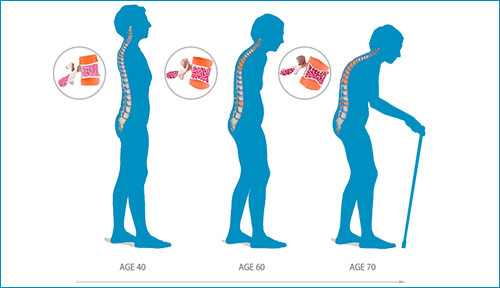What Is Osteoporosis?
Osteoporosis is a common disease that makes bones thinner, which makes them more likely to break. These fractures can lead to different health problems, like pain, bent posture, or trouble moving around. Many people lose bone gradually over many years. There are no symptoms that tell you that it’s happening. But it is possible to treat osteoporosis with medications and healthy lifestyle choices. If you make those good habits part of your life early on, you can prevent bone loss and lower the chances you’ll break a bone. It is easily reversible.
What Causes Osteoporosis?
Human body constantly breaks down old bone and rebuilds it. This process is called remodeling. As you grow up, your body builds more bone than it removes. During childhood, your bones become larger and stronger. Peak bone mass happens when you have the most bone you will ever have, usually in your early to mid-30s. At a certain age, the bone remodeling process changes. New bone comes in at a slower rate. This slowdown leads to a drop in the amount of bone you have. When bone loss becomes more severe, you have osteoporosis.

Osteoporosis Symptoms
Osteoporosis usually doesn’t cause any symptoms. But after many years, you may notice signs like back pain, a loss of height, or a stooped posture. For some people, the first sign they have the disease is a broken bone, usually in the spine or hip unless you get early screening done, or it gets noticed when you get an X ray for some other reason , the initial sign of osteoporosis is fractured or broken bone .
If osteoporosis becomes severe, the normal stress on bones from sitting, standing, coughing, or even hugging can cause painful fractures. After the first fracture, you’re more likely to get more.
For some people, the pain from a fracture may get better as the bone heals. But others will have long-lasting pain. You may feel stiff and have trouble being active.
Things that raise your chances of getting osteoporosis include:
- Family history: Osteoporosis seems to run in families. If your mother had a hip or spine fracture due to osteoporosis, chances are you’re more likely to get the disease.
- Gender: Women are four times more likely than men to get osteoporosis.
- Age: Though anyone can have osteoporosis, your chances go up with age. Women over 50 are most likely to get it. The older you are, the more likely you are to have fractures.
- Bone structure and body weight: Petite and thin women have higher chances for the disease, too. Weight loss after age 50 in women also seems to raise the chance of hip fractures, while weight gain lowers it. Small-boned, thin men have a greater chance of getting osteoporosis than men with larger frames and more body weight.
- History of fractures: Having one fracture due to osteoporosis means you’re likely to get more.
- Smoking: Studies show that cigarette smokers (past or current) have lower bone mass and higher fracture risks. Women who smoke have lower levels of the hormone estrogen — a key part of bone health.
- Medications: Some medications may make you more likely to have the disease. These include long-term use of steroids (prednisone), thyroid drugs, anti-seizure medicine, antacids, and other drugs.
How can I prevent osteoporosis before it starts?
Osteoporosis is a largely preventable disease. Prevention should start early. Getting enough calcium and vitamin D as a child and teenager can dramatically cut your risks of developing osteoporosis later in life. Even if you’re an adult, eating a healthy diet, getting enough calcium and vitamin D, exercising, and avoiding unhealthy lifestyle habits such as smoking and excessive drinking, may help prevent osteoporosis. Walking at least three times per week has proved to help reduce the progression of osteoporosis. After menopause, women who have osteopenia, or thinning of the bones, and who have a high probability for a future fracture from osteoporosis can consider drug therapies to prevent bone loss and reduce their risk of osteoporosis. To learn about osteoporosis prevention techniques, talk to your health care provider.
Am I getting enough calcium — and how much is too much?
The amount of calcium you need depends on your age. The Institute of Medicine recommends the following:
- Adolescents should get 1,300 milligrams of calcium a day.
- Adults from 19 to 50 years of age should get 1,000 milligrams of calcium a day.
- Adult women over the age of 50 should get 1,200 milligrams of calcium a day
- Adult men should receive 1,000 milligrams up to age 70 and 1,200 milligrams after age 70.
- Read food labels and select foods that contain 10% or more of the Daily Value for calcium. When food shopping, look for terms such as “high in calcium,” “fortified with calcium,” “calcium-rich,” or “excellent source of calcium.”
- If you think you’re coming up short, talk to your health care provider about ways you can boost your calcium levels in your diet. Talk to your doctor about what is best for you.
